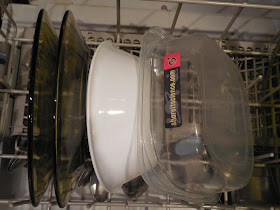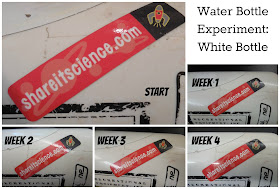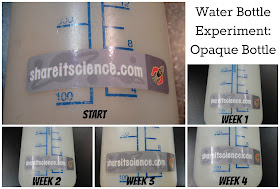Have you ever wondered if a product was
all it claimed to be? Is the quality worth the price? We don't always
have the luxury of testing products before we buy them, but designing
an experiment to test a product is a great way for children to
practice using the Scientific Method.
I have had many students complete
independent science projects that involve testing a product, from the
effectiveness of different toothpastes to name brand groceries versus
generic. It is a wonderful way to use science skills to explore a
real-world idea.
 |
| ©SBF |
Mabel's Labels provided the labels for this experiment, however this post was not otherwise sponsored by Mabel's Labels, and all ideas are those of the author. This post contains affiliate links. Please see disclosures tab at the top of page for further details.
We wanted to test our new Share it! Science labels from Mabel's Labels. So we devised an experiment.
Testable Question
Every good science experiment should
begin with a testable question. "Will the pumpkin sink or
float?" is an example of a testable question. "How do birds
fly?" is not a testable question.
Our testable question for our label experiment was: "Will the label fall off or stay sticky after several
trips through the dishwasher?" and a secondary question "Will a
label on a water bottle fade or stay bright after spending a month in
and out of a backpack?"
Developing a Hypothesis
Before any experiment, it is important
to consider a hypothesis. This is an educated prediction. Often
students, particularly younger ones are tempted to change their
hypothesis to meet their actual results after they have completed an
investigation. It is ok if your hypothesis ends up being incorrect!
The best science experiments lead to new questions!
Our hypotheses for our Mabel's Labels
experiment were: "Labels will begin to peel after 3 trips
through the dishwasher." and "The label on the water bottle
will fade from being scratched in the backpack."
Before an experiment, it is important
to plan how you will complete it. A good experiment is something that
can be repeated by another person to get similar results.
Our methods:
Dishwasher Experiment
1. Put a label on a plastic food
container
2. Take a photo of the label
3. Place food container in dishwasher
4. Run dishwasher on "Adaptive Wash" cycle
5. Take a photo and observe changes
6. Repeat steps 3-5 four times
Water Bottle Experiment
1. Put labels on 2 different water
bottles
2. Take a photo of each label
3. Use water bottles normally (to
school and sports practice)
4. Once a week, take a photo and
observe changes
5. Repeat steps 3-4 for one month
Experiment and Make Observations
There are qualitative observations and
quantitative observations. Qualitative observations describe the
physical qualities of something, i.e. the leaf is red. Quantitative
observations describe measurable qualities, i.e. the leaf has 3
points.
Quantitative observations are easier to
analyze in a graph or table. They are not as subjective as
qualitative observations. You can create a scale to measure
qualitative observations in a quantitative way. This is what we did
for our experiment.
| Observation # | 1= No change | 2= Color faded slightly | 3= Color faded slightly, and/or visible scratch or dent, and/or wear or peeling beginning on corners | 4= Color faded more significantly, and/or 2-3 scratches or dents, and/or peeling beginning in multiple places | 5= Color faded almost completely, and/or more than 3 scratches or dents, and/or significant peeling |
Results
Your results should accurately describe
the observations in the experiment. Here are our data tables and photos:
Dishwasher
| Observation # | 1= No change | 2= Color faded slightly | 3= Color faded slightly, and/or visible scratch or dent, and/or wear or peeling beginning on corners | 4= Color faded more significantly, and/or 2-3 scratches or dents, and/or peeling beginning in multiple places | 5= Color faded almost completely, and/or more than 3 scratches or dents, and/or significant peeling |
| 1 | 1 | ||||
| 2 | 1 | ||||
| 3 | 1 | ||||
| 4 | 1 |
| Observation # | 1= No change | 2= Color faded slightly | 3= Color faded slightly, and/or visible scratch or dent, and/or wear or peeling beginning on corners | 4= Color faded more significantly, and/or 2-3 scratches or dents, and/or peeling beginning in multiple places | 5= Color faded almost completely, and/or more than 3 scratches or dents, and/or significant peeling |
| Week 1 | 1- no change | ||||
| Week 2 | 3- one small scratch | ||||
| Week 3 | 3- same | ||||
| Week 4 | 4- two small scratches |
| Observation # | 1= No change | 2= Color faded slightly | 3= Color faded slightly, and/or visible scratch or dent, and/or wear or peeling beginning on corners | 4= Color faded more significantly, and/or 2-3 scratches or dents, and/or peeling beginning in multiple places | 5= Color faded almost completely, and/or more than 3 scratches or dents, and/or significant peeling |
| Week 1 | 1- no change | ||||
| Week 2 | 1- no change | ||||
| Week 3 | 3- one small scratch | ||||
| Week 4 | 3- same |
Our data could also be made into a
graph for analysis.
We found that neither of our hypotheses
were correct. After 4 trips through the dishwasher we saw no
perceivable changes to the label. Despite normal wear and tear we
only saw some small scratches on the labels on the water bottles.
Their colors did not fade. Although we were incorrect, we were happy
to see the quality of the labels!
It is important to consider the
variables and conditions of the experiment when analyzing results.
Here are things we might change and some new questions to consider
before doing the experiment again, in order to be more accurate.
- We would assure that the container was in the same position in the dishwasher during each wash cycle. We need to take into account the make-up of the dishwasher. How can we control for the level of food or grease that is in the water?
- We would repeat the dishwasher experiment many more times.
- How do we control for conditions with the water bottle experiment? Each day is different. (Maybe specific controllable tests.)
- We would observe the water bottles for a longer period of time.
- Control lighting and resolution of photos for more accurate data
It is ok for an experiment to result in
further questions! In fact, most experiments do!
We can conclude from our results that
Mabel's Labels really hold up to daily life! I would definitely
purchase them again. What sort of product testing could you introduce
to your children or students to help them practice the scientific
method?






No comments:
Post a Comment